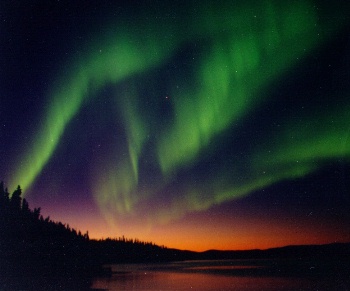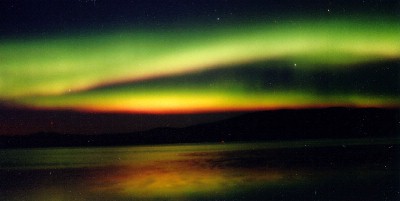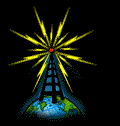
![]()

![]()
*Note The aurora photos on this website were all taken by © Jan Curtis. To view these in full size and to see more of these images, click on the picture above!
The Aurora Borealis or "Northern Lights" can make for some interesting propagation. I am located at 52.27 Degrees N. Latitude and 113.84 Degrees W. Longitude. From this location we experience many geomagnetic disturbances every year. When the northern lights are displaying themselves it makes for a good indicator that the 28, 50, 144, 222, and even 432 MHz bands are open and a lot of new contacts can be made up to about 1500 miles.
*Note In the southern hemisphere this phenomenon is referred to as aurora australis.
When there are large storms on the sun, particles are thrown outward away from the sun. If the earth happens to be in the path of the spewed particles, they are trapped by the earth's magnetic field in the polar regions. These ionize the E-layer of the ionosphere and will affect radio communications.
Radio signals on the ham bands below 20 MHz are generally absorbed and the bands will sound dead. Signals above 20 MHz are scattered and reflected. Signals on 50 and 144 MHz sound very "Distorted" and "Watery". Most of the time the distortion is so bad that CW is the only mode that will be usable.
An easy way to tell if there is any unusual or elevated geomagnetic activity is to listen to WWV on 2.5, 5, 10, 15, or 20 MHz at 18 minutes after the hour. At this time a solar report and solar forecast are given. It consists of the Solar Flux, A-Index and the K-Index. If the K-Index is greater than 3, you can pretty well be guaranteed that there will be some auroral activity and you should be able to make some auroral contacts if you are located in the northern latitudes. Check out the following graph showing the real time Planetary K-Index. This graph is updated every 15 minutes.
Another useful tool for checking the Solar Flux, A-Index and K-Index is to visit the OH2AQ Webcluster. This website will give you the latest solar information as reported by WWV and posted by amateur radio operators, as well as DX Spotting on all bands. You might also be interested in monitoring the Solar Flux, A-Index and K-Index Outlook Reports.
A high gain beam antenna, a high quality low noise pre-amp and a high power linear amplifier are desired when working aurora, but not always necessary. During my first few years of auroral activity I was using a power output of only 7 watts on 144 MHz and a home-brew 16 element RH circular polarized cross-yagi antenna. This setup allowed me to work several states and provinces. On 50 MHz I was running 8 watts output to a 3 element horizontally polarized yagi. A lot of contacts were made here as well.
At the present time I am using a Ten-Tec T-Kit 1209 144-50 MHz transverter for 6 meters.This is being used with my Kenwood TR-751A 2 meter multi-mode transceiver as the I.F. This gives me approximately 9 watts output, which drives a Mirage A-1015G 6 meter amplifier to about 150 watts output. My 6 meter antenna is an A505S 5 element cushcraft yagi. For 2 meters I'm using my Kenwood TR-751A 2 meter rig with a homebrew amplifier using a single 4CX250 tube. This amp was built by Ed, VE6BEK, and works very well. I run it at about 200 watts output. I'm using my 16 element cross-yagi for the antenna for aurora work.
*Note If you have the capability of stacking several high gain antennas and feeding them with a full legal limit linear amplifier, your results will be much better. With this type of propagation the higher the ERP (Effective Radiated Power) the better.
Have a listen on 144.200 Mhz and 50.125 MHz the next time you notice the northern lights. These are the most active frequencies on the 2 meter and 6 meter band.

Some Aurora Links
